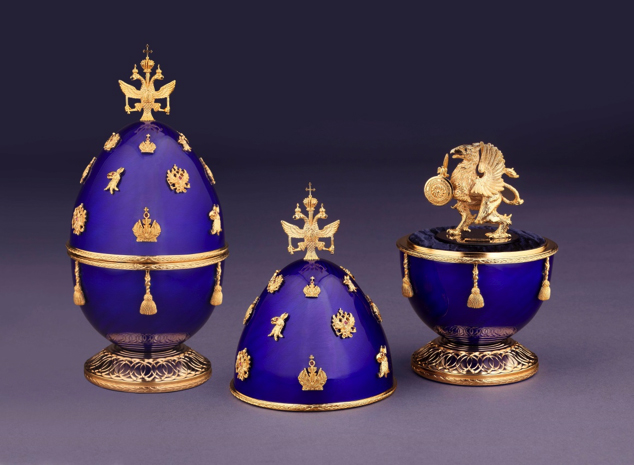The Romanovs ruled the country from 1613 until 1917. In 1613, a council of more than 800 delegates from various parts of Russia elected Mikhail Romanov as Russia’s Tsar.
Celebrating the 400th Anniversary, the Egg features 18 miniature decorations representing the 18 Romanov Tsars. The surprise within is the Romanov Griffin.

The dynasty of Mikhail Romanov’s successors ruled Russia for more than 300 years, untill 1917. These three centuries were a glorious time for Russia. Within these years, the country’s territory increased so much that Russia became the world’s largest empire with a well-developed economy, very influential in the world.
The new young Tsar realized that he had to reunite the country that had suffered much during the long period of political instability. All his successors, tsars and emperors of the Romanov dynasty, lead a similar policy of unification and managed quite well to make Russia large and strong.
It was not noblemen or high-ranking officials who persuaded the council’s participants to vote for Mikhail Romanov, but the Cossacks, people who lived in southern Russia and Ukraine, whose occupation, as a rule, was military service, and who had their own culture and traditions.
Even after Mikhail Romanov was elected at this council, he did not immediately become Russia’s Tsar. Envoys were sent to various parts of Russia to ask people what they thought of the new candidate for the Russian throne. Only after the majority of people responded that they supported Mikhail Romanov, an official decree that announced him the Tsar was released.
This was probably not nationwide democratic elections from the contemporary point of view but for 17th -century Russia, this was very democratic. It would be anachronism to expect more democracy in Russia at that time.
The choice which the council’s participants made was an expression of the will of the entire Russian people. Russia needed a ruler who would be able to make it strong and united and who would preserve the Russian culture and the Orthodox Christian faith – and that is what Mikhail Romanov and all his successors, up to the last Russian Emperor Nickolas II, always did. True, Russia is a multinational and a multi-confessional country, but it is impossible to deny the fact that the majority of the country’s population are ethnic Russians and Orthodox Christians. Russian politicians should always take this into account.
After the council, a delegation was sent to the city of Kostroma, where Mikhail Romanov lived at that time. It took the young Tsar several months to get from Kostroma to Moscow, because he stopped in all the large cities, which were on the way, for some time.
Mikhail might have never reached Moscow, because the Poles, who wanted to take revenge for their defeat in Russia, had plotted to intercept the newly-elected Tsar on his way to the capital. It is hard to say what might have come of their plot if not for a local farmer, who said to the Poles that he would lead them to the place where the young Tsar was, but led them instead into a deep forest. When the Poles realized that the farmer had deceived them, they killed him. The brave farmer died, but Mikhail Romanov’s life was saved!
Under Mikhail Romanov’s rule, new territories were added to Russia, a large network of manufacturers appeared in the country, and diplomatic relations with Europe’s leading countries, as well as with Turkey and Persia, were established.